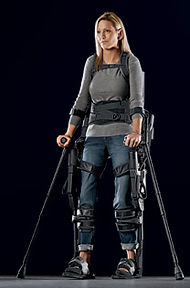
TRANSHUMANISM
Background
Ekso™ is a bionic suit, also known as an exoskeleton or wearable robot, developed by Ekso Bionics.
Ekso Bionics has been developing exoskeletons for the past decade (Gannon, 2013). Funded by the DARPA (Gannon, 2013), this project initially started out as a joint with the military, with the aim to provide the soldiers with super human strength (Consumersprotections.com, 2012). However, potential was seen in the medical field and it was then further developed to enable those with spinal cord injuries or alternative forms of lower extremity paralysis to stand and walk (Caula, 2013).
One bionic suit costs about $130000 (Technocrazed.com, 2013).
Ekso
Aim
To aid individuals in their recovery phases, and be able to stand up and walk again, as well as provide them with a mobility device just like the wheelchair, which till date is the only mobility tool to help this group of people function like the rest (Gannon, 2013).
To help wheelchair- bound people live a more fulfilling life, by providing them a device to restore their basic need, and being able to walk again (Gannon, 2013).

Shoulder Straps They help in stabilizing the upper body and do not transfer any weight to the user’s shoulders (Newlaunches, 2012).
Hip and Knee To mimic the muscular nature of joint flexion and extension, sensors attached to the hips and knees emits electric currents to stimulate motors to regulate the intended joint movements (Newlaunches, 2012).
Foot The weight of the Ekso is transferred through the thigh and shank links, to the foot plate and lastly, to the ground, relieving the user to bear this weight (Newlaunches, 2012).
Features
How it works
The legs of the Ekso suit are powered by motors, which takes over the role of the neuro-muscular system. When the user shifts his or her weight forward in a lateral fashion, and repeats this process, walking is therefore achieved when assisted with the Ekso (Caula, 2013).
As compared to prosthetics which usually has one moving component, Ekso has four moving components in one system. Four electric motors are used – two each at the hips and knees, powered by a battery pack at the back (Gannon, 2013). There is also a computer in between the two batteries in the middle, and this computer essentially controls the entire Ekso suit (Gannon, 2013).
The outer frame of the suit is built in a way to imitate the bone structure of the user, and the suit also integrated 15 sensors which strive to recreate the nerve system itself (Gannon, 2013).
Don/Doff Link The hips of the Ekso suit will swing apart, allowing the user to get in and out of the exoskeleton easily and quickly (Newlaunches, 2012).
Thigh and Shank Links The Ekso’s thigh and shank links are made of aluminium, and helps to support the user (as heavy as 100 kilograms) due to its strength and rigidity. It can also be adjusted accordingly to the user’s height (between 5’2″ and 6’2″) (Newlaunches, 2012).
Ankle the Ekso’s ankles are made of titanium for increased strength and they act as pivot joints. Its simple design currently, does not allow the user to walk on inclined grounds (Newlaunches, 2012).
Torso The compartment at the back of the exoskeleton holds lithium-ion batteries and two microprocessors (Newlaunches, 2012).



Reproduced from Consumersprotections.com (2012)
Reproduced from Technocrazed.com (2013)
Reproduced from Newlaunches (2012)
Reproduced from Lapowsky (2012)
Reproduced from Theengineer (2011)